Mechanism of Precipitate Microstructure Affecting Fatigue Behavior of 7020 Aluminum Alloy
Abstract
1. Introduction
2. Experimental Procedures
2.1. Material and Treatment
2.2. Microstructural Characterization
2.3. Property Tests
3. Results
3.1. Grain Structure
3.2. Aging Characteristics
3.3. Tensile Properties
3.4. Fatigue Strength
3.5. Fatigue Crack Growth Behavior
4. Discussion
4.1. Fatigue Crack Initiation
4.2. Fatigue Crack Growth Mechanism
5. Conclusions
- 1.
- The GPI zones below the critical size in the under-aged alloy can be repeatedly sheared by dislocations, making it difficult for fatigue cracks to initiate. Moreover, the fatigue crack growth path is tortuous when the precipitates can be repeatedly sheared by dislocations caused by cyclic loading, and the FCGR is 58.1% slower than that of the peak-aged alloy at ΔK of 10 MPa·m1/2.
- 2.
- The alloys with unshearable precipitates, continuous GBPs and narrow PFZs are prone to initiate fatigue crack and reduce fatigue strength.
- 3.
- Unshearable precipitates with moderate size in the over-aged alloy improve the RICC effect by particles clamping at the crack tip. The soft matrix with appropriate width between the precipitates can promote the slip reversibility and relax the crack tip stress. The fatigue strength of the moderately over-aged alloy is about 122.1 MPa at 107 cycles of loading, and the FCGR is 35.6% slower than that of the peak-aged alloy at ΔK of 10 MPa·m1/2. Moderate over-aging improved fatigue performance of the alloy.
Author Contributions
Funding
Conflicts of Interest
References
- Qin, C.; Gou, G.; Che, X.; Chen, H.; Chen, J.; Li, P.; Gao, W. Effect of composition on tensile properties and fracture toughness of Al-Zn-Mg alloy (A7N01S-T5) used in high speed trains. Mater. Des. 2016, 91, 278–285. [Google Scholar] [CrossRef]
- Liu, W.Y.; Wu, D.T.; Duan, S.W.; Wang, T.; Zou, Y. A study on fatigue crack propagation for friction stir welded plate of 7N01 Al-Zn-Mg alloy by EBSD. Materials 2020, 13, 330. [Google Scholar] [CrossRef] [PubMed]
- Li, S.; Dong, H.G.; Shi, L.; Wang, X.X.; Liu, Z.Y.; Shangguan, L.J.; Tian, Y.S. The effects of heat straightening temperature on the microstructure and properties of 7N01 aluminum alloy. Materials 2019, 12, 2949. [Google Scholar] [CrossRef] [PubMed]
- Xiao, T.; Deng, Y.L.; Ye, L.Y.; Lin, H.Q.; Shan, C.J.; Qian, P.W. Effect of three-stage homogenization on mechanical properties and stress corrosion cracking of Al-Zn-Mg-Zr alloys. Mater. Sci. Eng. A 2016, 675, 280–288. [Google Scholar] [CrossRef]
- Li, B.; Wang, X.M.; Chen, H.; Hu, J.; Huang, C.; Gou, G.Q. Influence of heat treatment on the strength and fracture toughness of 7N01 aluminum alloy. J. Alloys Compd. 2016, 678, 160–166. [Google Scholar] [CrossRef]
- Gurbuz, R.; Sarioglu, F. Fatigue crack growth behaviour in aluminium alloy 7475 under different aging conditions. Mater. Sci. Technol. 2001, 17, 1539–1543. [Google Scholar] [CrossRef]
- Xia, P.; Liu, Z.; Bai, S.; Lu, L.; Gao, L. Enhanced fatigue crack propagation resistance in a superhigh strength Al-Zn-Mg-Cu alloy by modifying RRA treatment. Mater. Charact. 2016, 118, 438–445. [Google Scholar] [CrossRef]
- Engdahl, T.; Hansen, V.; Warren, P.J.; Stiller, K. Investigation of fine scale precipitates in Al-Zn-Mg alloys after various heat treatments. Mater. Sci. Eng. A 2002, 327, 59–64. [Google Scholar] [CrossRef]
- Berg, L.K.; Gjønnes, J.; Hansen, V.; Li, X.Z.; Knutson-Wedel, M.; Waterloo, G.; Schryvers, D.; Wallenberg, L.R. GP-zones in Al-Zn-Mg alloys and their role in artificial aging. Acta Mater. 2001, 49, 3443–3451. [Google Scholar] [CrossRef]
- Sha, G.; Cerezo, A. Early-stage precipitation in Al-Zn-Mg-Cu alloy (7050). Acta Mater. 2004, 52, 4503–4516. [Google Scholar] [CrossRef]
- Lendvai, J.; Honyek, G.; Kovacs, I. Dissolution of second phases in an Al-Zn-Mg alloy investigated by calorimetric method. Scripta Mater. 1979, 13, 593–594. [Google Scholar] [CrossRef]
- Li, X.Z.; Hansen, V.; Gjonnes, J.; Wallenberg, L.R. HREM study and structure modeling of the eta’ phase, the hardening precipitates in commercial Al-Zn-Mg alloys. Acta Mater. 1999, 47, 2651–2659. [Google Scholar] [CrossRef]
- Hirosawa, S.; Oguri, Y.; Ogura, T.; Sato, T. Formation mechanisms of precipitate free zones in age-hardenable Al alloys. Mater. Forum 2004, 28, 666–671. [Google Scholar]
- Abe, M.; Asano, K.; Fujiwara, A. Influence of the precipitate-free zone width on the tensile properties of an Al-6 Wt pct Zn-1.2 Wt pct Mg alloy. Metall. Trans. 1973, 4, 1499–1505. [Google Scholar]
- Park, J.K.; Ardell, A.J. Microstructures of the commercial 7075 Al alloy in the T651 and T7 tempers. Metall. Trans. A 1983, 14, 1957–1965. [Google Scholar] [CrossRef]
- Marlaud, T.; Deschamps, A.; Bley, F.; Lefebvre, W.; Baroux, B. Evolution of precipitate microstructures during the retrogression and re-ageing heat treatment of an Al-Zn-Mg-Cu alloy. Acta Mater. 2010, 58, 4814–4826. [Google Scholar] [CrossRef]
- Buha, J.; Lumley, R.; Crosky, A. Secondary ageing in an aluminium alloy 7050. Mater. Sci. Eng. A 2008, 492, 1–10. [Google Scholar] [CrossRef]
- Desmukh, M.N.; Pandey, R.; Mukhopadhyay, A. Effect of aging treatments on the kinetics of fatigue crack growth in 7010 aluminum alloy. Mater. Sci. Eng. A 2006, 435, 318–326. [Google Scholar] [CrossRef]
- Mura, T.; Vilmann, C. Fatigue crack propagation related to a dislocation distribution. In Defects and Fracture; Springer: Dordrecht, The Netherlands, 1982; pp. 81–90. [Google Scholar]
- Vasudevan, A.; Bretz, P. Near-Threshold Fatigue Crack Growth Behavior of 7xxx and 2xxx Alloys: A Brief Review, Fatigue Crack Growth Threshold Concepts; The Metallurgical Society of AIME: Warrendale, PA, USA, 1984; pp. 25–42. [Google Scholar]
- Kamp, N.; Gao, N.; Starink, M.; Sinclair, I. Influence of grain structure and slip planarity on fatigue crack growth in low alloying artificially aged 2xxx aluminium alloys. Int. J. Fatigue 2007, 29, 869–878. [Google Scholar] [CrossRef]
- Chen, X.; Liu, Z.; Xia, P.; Ning, A.; Zeng, S. Transition of crack propagation from a transgranular to an intergranular path in an overaged Al-Zn-Mg-Cu alloy during cyclic loading. Met. Mater. Int. 2013, 19, 197–203. [Google Scholar] [CrossRef]
- Suresh, S.; Palmer, I.; Lewis, R. The effect of environment on fatigue crack growth behavior of 2021 aluminum alloy. Fatigue Fract. Eng. Mater. Struct. 1982, 5, 133–150. [Google Scholar] [CrossRef]
- Vasudevan, A.; Suresh, S. Influence of corrosion deposits on near-threshold fatigue crack growth behavior in 2xxx and 7xxx series aluminum alloys. Metall. Trans. A 1982, 13, 2271–2280. [Google Scholar] [CrossRef]
- Suresh, S.; Vasudevan, A.; Bretz, P. Mechanisms of slow fatigue crack growth in high strength aluminum alloys: Role of microstructure and environment. Metall. Trans. A 1984, 15, 369–379. [Google Scholar] [CrossRef]
- Stiller, K.; Warren, P.J.; Hansen, V.; Angenete, J.; Gjønnes, J. Investigation of precipitation in an Al-Zn-Mg alloy after two-step ageing treatment at 100° and 150 °C. Mater. Sci. Eng. A 1999, 270, 55–63. [Google Scholar] [CrossRef]
- Metallic Materials-Fatigue Testing-Statistical Planning and Analysis of Data; ISO 12107; International Organization for Standardization: Geneva, Switzerland, 2012.
- Al-Rubaie, K.S.; Barroso, E.K.L.; Godefroid, L.B. Fatigue crack growth analysis of pre-strained 7475-T7351 aluminum alloy. Int. J. Fatigue 2006, 28, 934–942. [Google Scholar] [CrossRef]
- Bai, S.; Liu, Z.; Gu, Y.; Zhou, X.; Zeng, S. Microstructures and fatigue fracture behavior of an Al-Cu-Mg-Ag alloy with a low Cu/Mg ratio. Mater. Sci. Eng. A 2011, 530, 473–480. [Google Scholar] [CrossRef]
- Gupta, V.K.; Agnew, S.R. Fatigue crack surface crystallography near crack initiating particle clusters in precipitation hardened legacy and modern Al-Zn-Mg-Cu alloys. Int. J. Fatigue 2011, 33, 1159–1174. [Google Scholar] [CrossRef]
- Suresh, S. Further remarks on the micromechanisms of fatigue crack growth retardation following overloads. Eng. Fract. Mech. 1985, 21, 1169–1170. [Google Scholar] [CrossRef]
- Kung, C.; Fine, M. Fatigue crack initiation and microcrack growth in 2024-T4 and 2124-T4 aluminum alloys. Metall. Trans. A 1979, 10, 603–610. [Google Scholar] [CrossRef]
- Chan, K.S. Roles of microstructure in fatigue crack initiation. Int. J. Fatigue 2010, 32, 1428–1447. [Google Scholar] [CrossRef]
- Suresh, S.; Wang, Z. Fatigue of Materials, 2nd ed.; National Defense Industry Press: Beijing, China, 1999; pp. 234–252. [Google Scholar]
- Bai, S.; Liu, Z.; Zhou, X.; Gu, Y.; Yu, D. Strain-induced dissolution of Cu-Mg co-clusters and dynamic recrystallization near a fatigue crack tip of an underaged Al-Cu-Mg alloy during cyclic loading at ambient temperature. Scripta Mater. 2011, 64, 1133–1136. [Google Scholar] [CrossRef]
- Kovács, I.; Lendvai, J.; Ungar, T.; Groma, G.; Lakner, J. Mechanical properties of AlZnMg alloys. Acta Mater. 1980, 28, 1621–1631. [Google Scholar] [CrossRef]
- Liu, M.; Liu, Z.; Bai, S.; Xia, P.; Ying, P.; Zeng, S. Solute cluster size effect on the fatigue crack propagation resistance of an underaged Al-Cu-Mg alloy. Int. J. Fatigue 2016, 84, 104–112. [Google Scholar] [CrossRef]
- Chen, X.; Liu, Z.; Lin, M.; Ning, A.; Zeng, S. Enhanced fatigue crack propagation pesistance in an Al-Zn-Mg-Cu alloy by retrogression and reaging treatment. J. Mater. Eng. Perform. 2012, 21, 2345–2353. [Google Scholar] [CrossRef]
- Borrego, L.P.; Costa, J.M.; Silva, S.; Ferreira, J.M. Microstructure dependent fatigue crack growth in aged hardened aluminium alloys. Int. J. Fatigue 2004, 26, 1321–1331. [Google Scholar] [CrossRef]
- Yi, L.W.; Pan, Q.L.; Li, L.W.; Bo, L.; Ying, W. Effect of retrogression and reaging treatment on the microstructure and fatigue crack growth behavior of 7050 aluminum alloy thick plate. Mater. Des. 2014, 55, 857–863. [Google Scholar]
- De, P.S.; Mishra, R.S.; Smith, C.B. Effect of microstructure on fatigue life and fracture morphology in an aluminum alloy. Scripta Mater. 2009, 60, 500–503. [Google Scholar] [CrossRef]
- Chen, D.L.; Chaturvedi, M.C. Near-threshold fatigue crack growth behavior of 2195 aluminum-lithium-alloy—Prediction of crack propagation direction and influence of stress ratio. Metall. Mater. Trans. A 2000, 31, 1531–1541. [Google Scholar] [CrossRef]
- Pearson, S. Initiation of fatigue cracks in commercial aluminium alloys and the subsequent propagation of very short cracks. Eng. Fract. Mech. 1975, 7, 235–247. [Google Scholar] [CrossRef]
- Suresh, S.; Ritchie, R. Propagation of short fatigue cracks. Int. Met. Rev. 1984, 29, 445–475. [Google Scholar] [CrossRef]
- Lankford, J. The growth of small fatigue cracks in 7075-T6 aluminum. Fatigue Fract. Eng. Mater. 1982, 5, 233–248. [Google Scholar] [CrossRef]
- Csontos, A.A.; Starke, E.A. The effect of inhomogeneous plastic deformation on the ductility and fracture behavior of age hardenable aluminum alloys. Int. J. Plasticity 2005, 21, 1097–1118. [Google Scholar] [CrossRef]
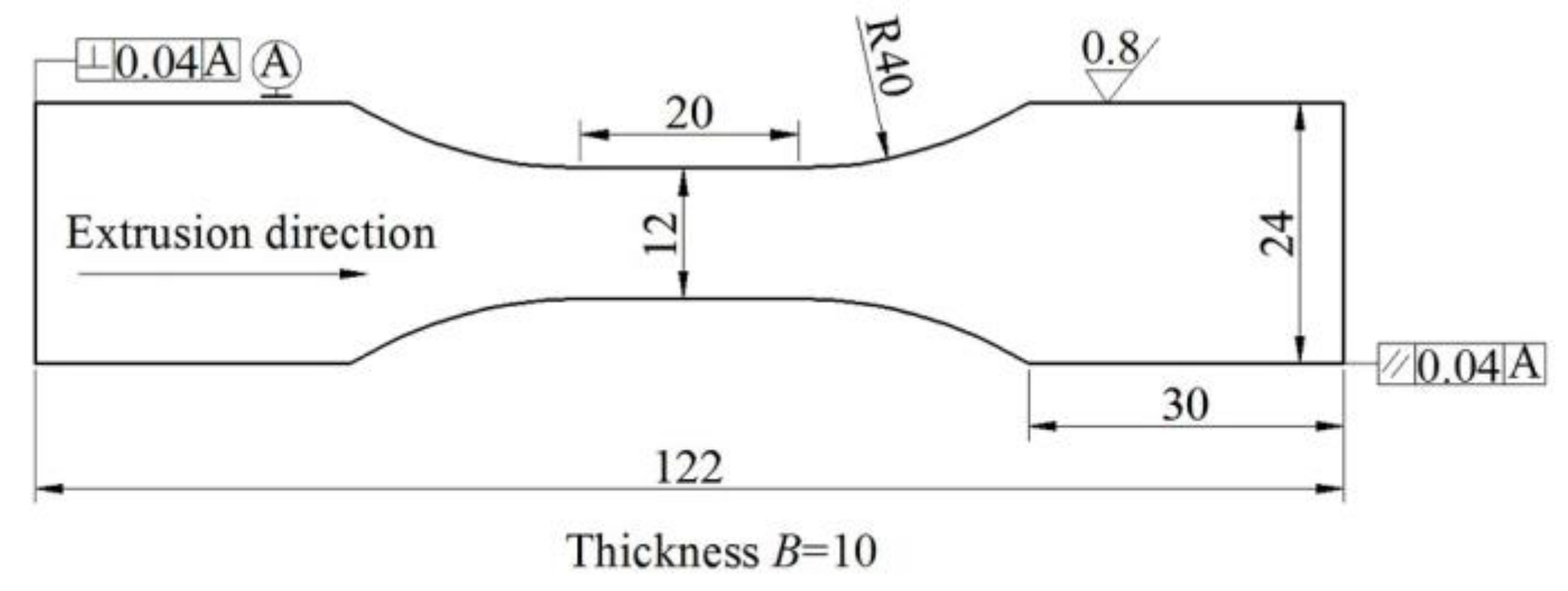
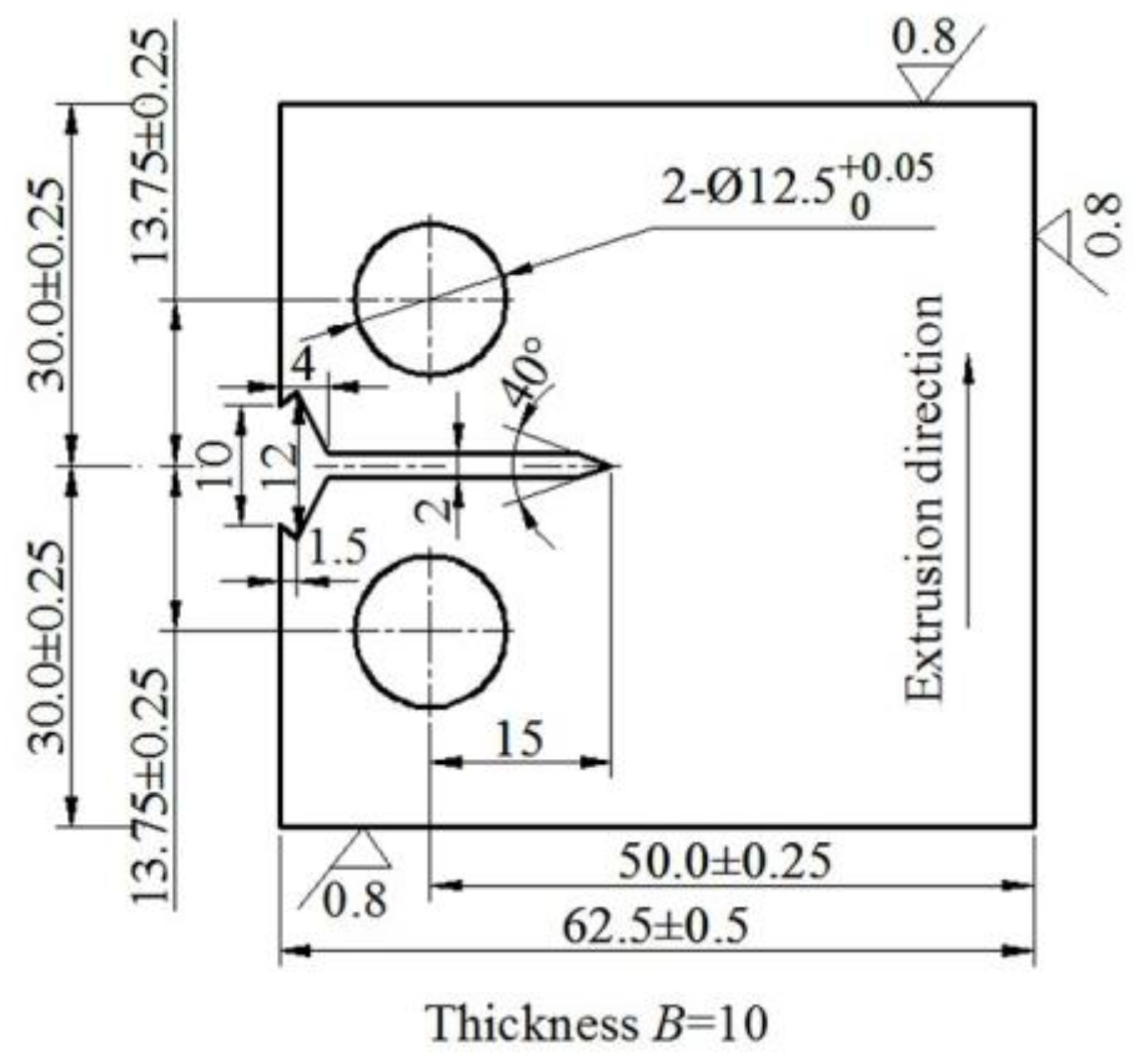

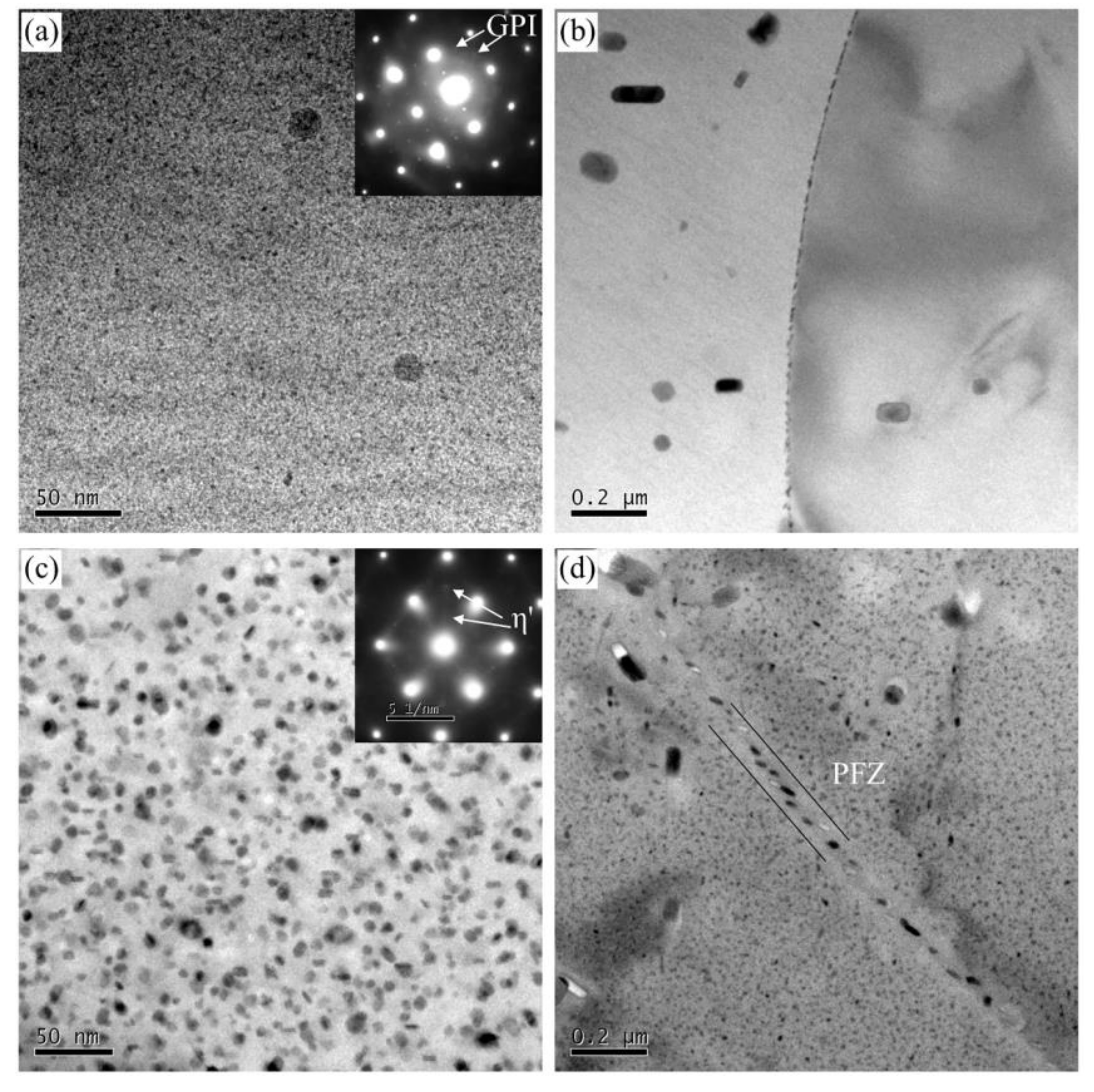
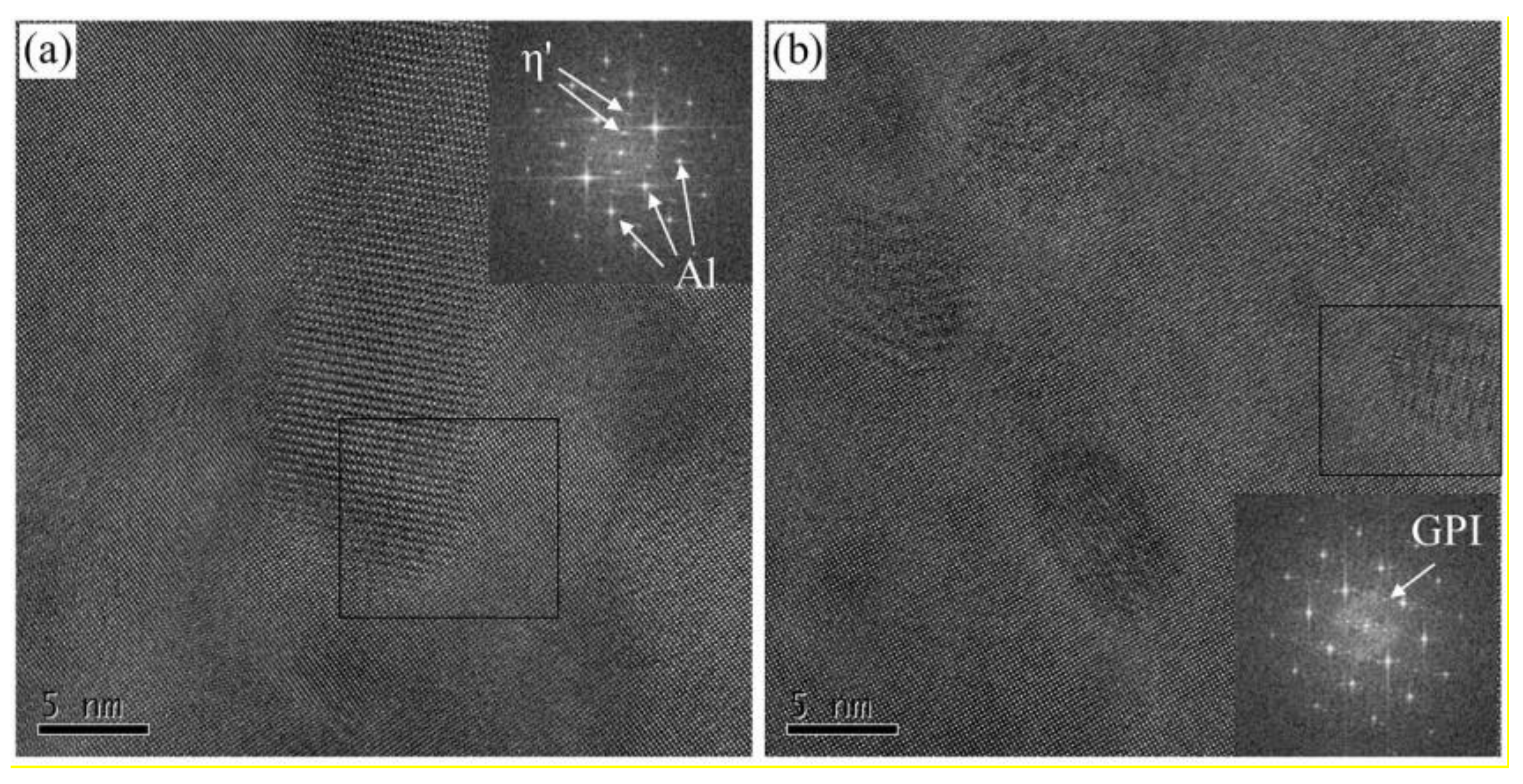



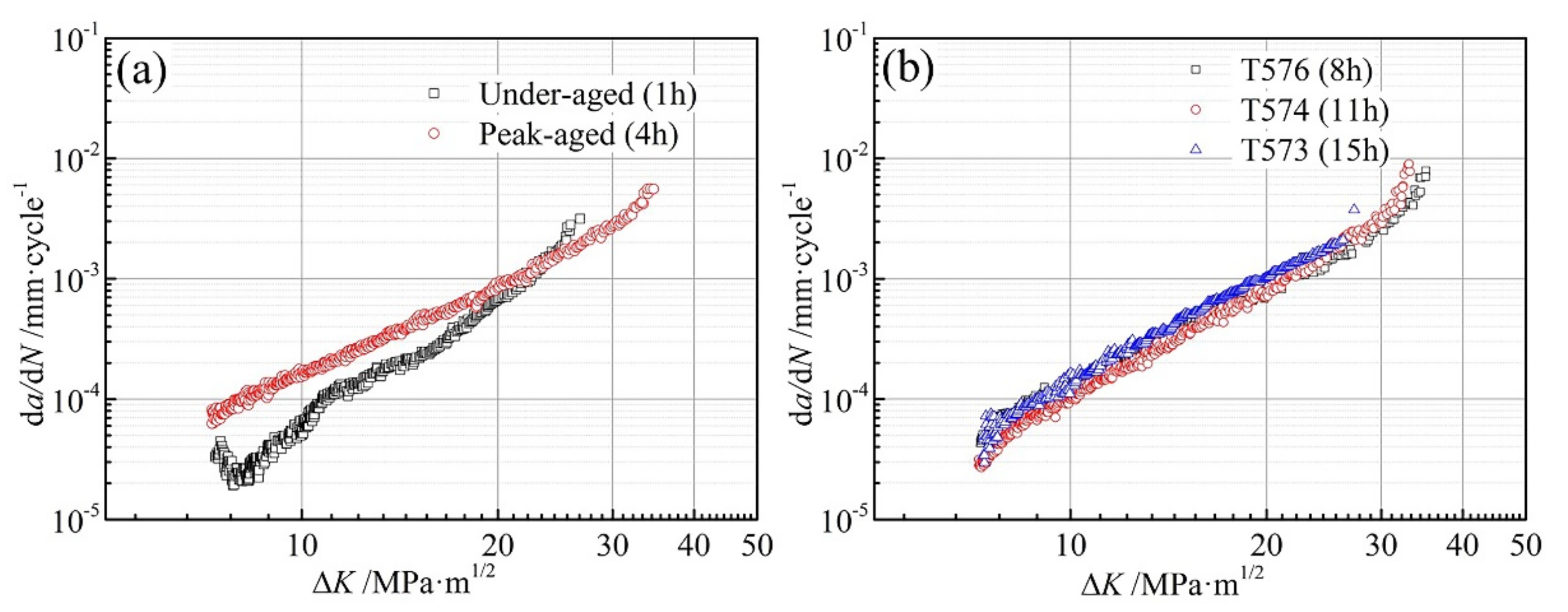
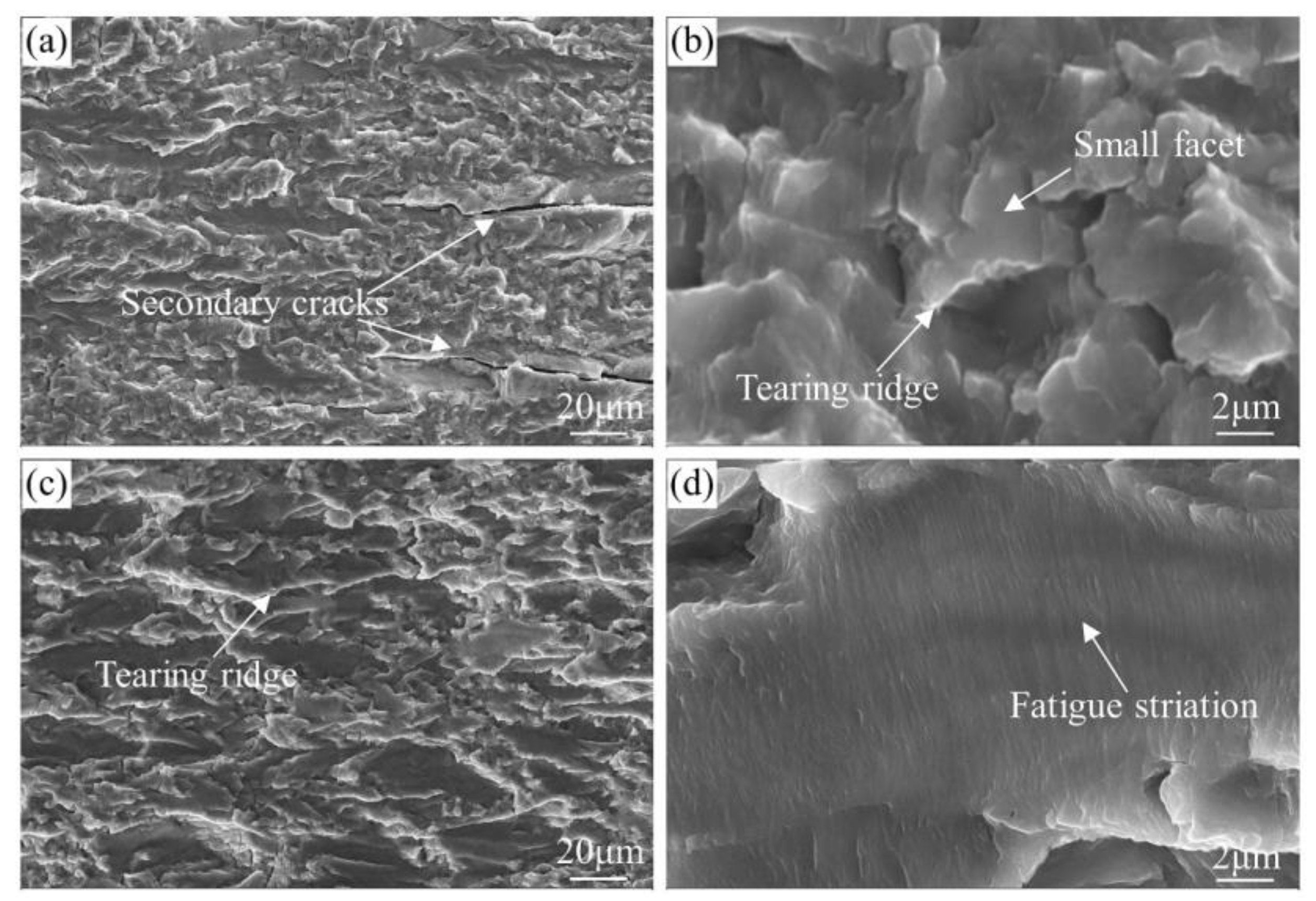
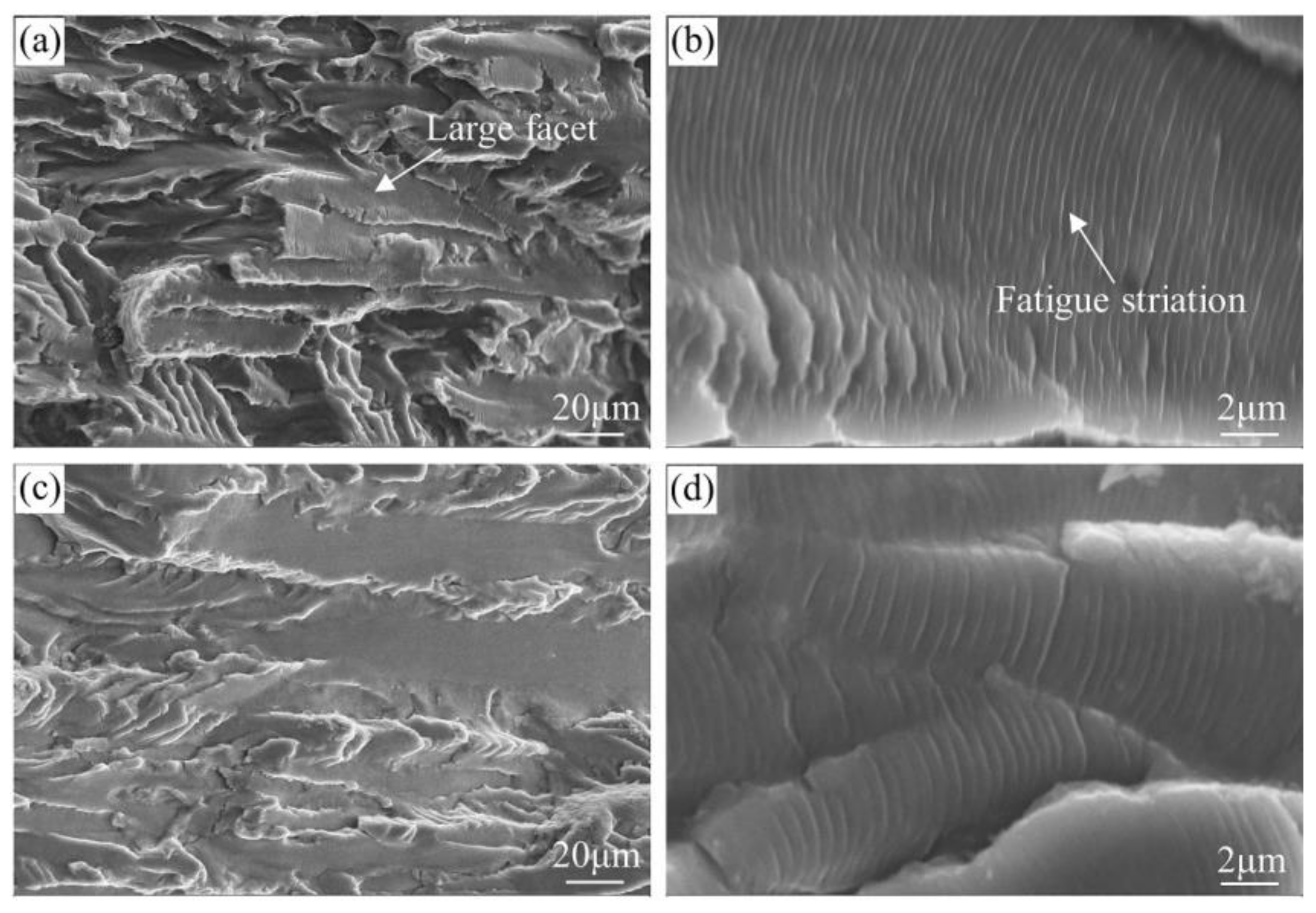
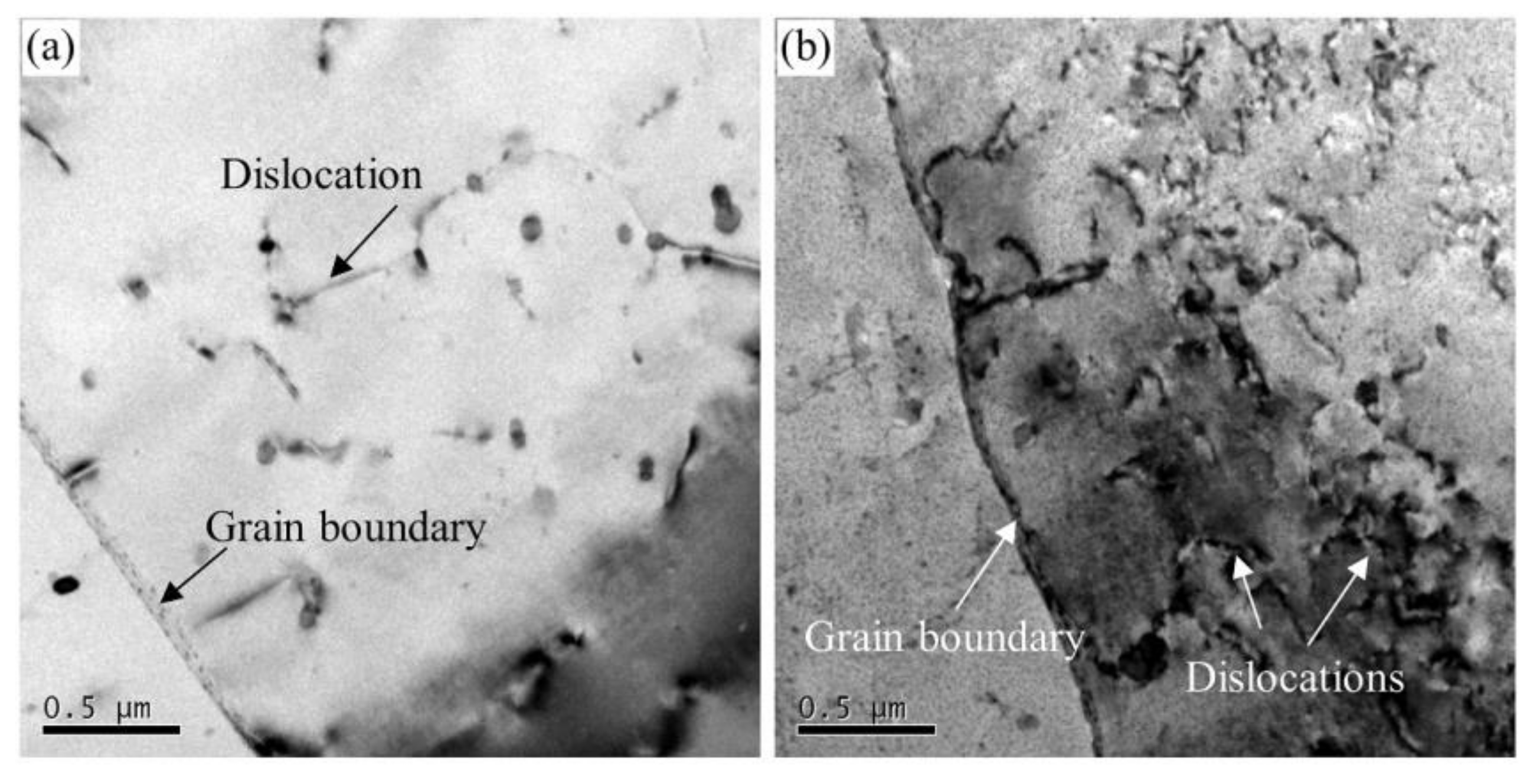
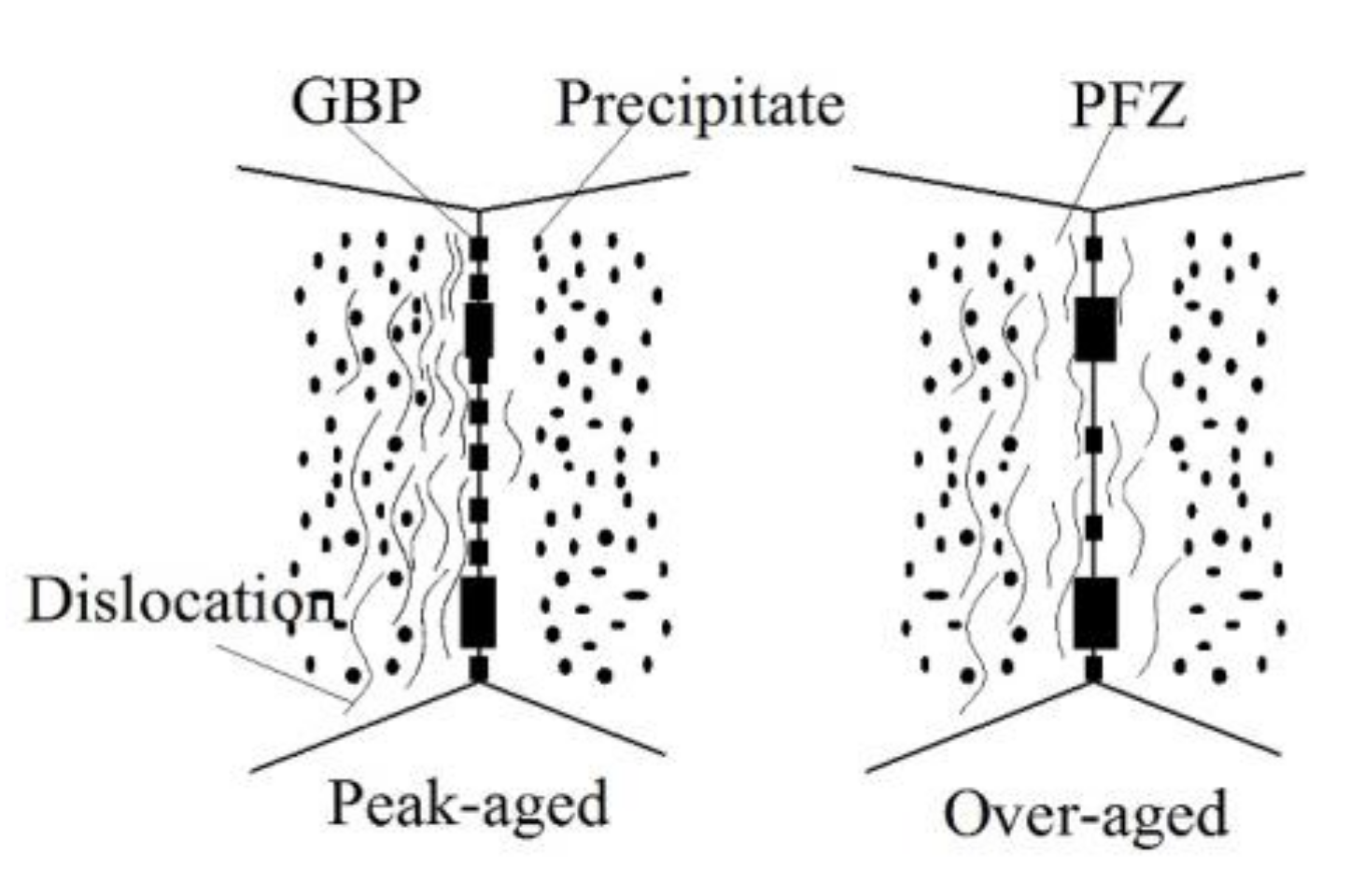



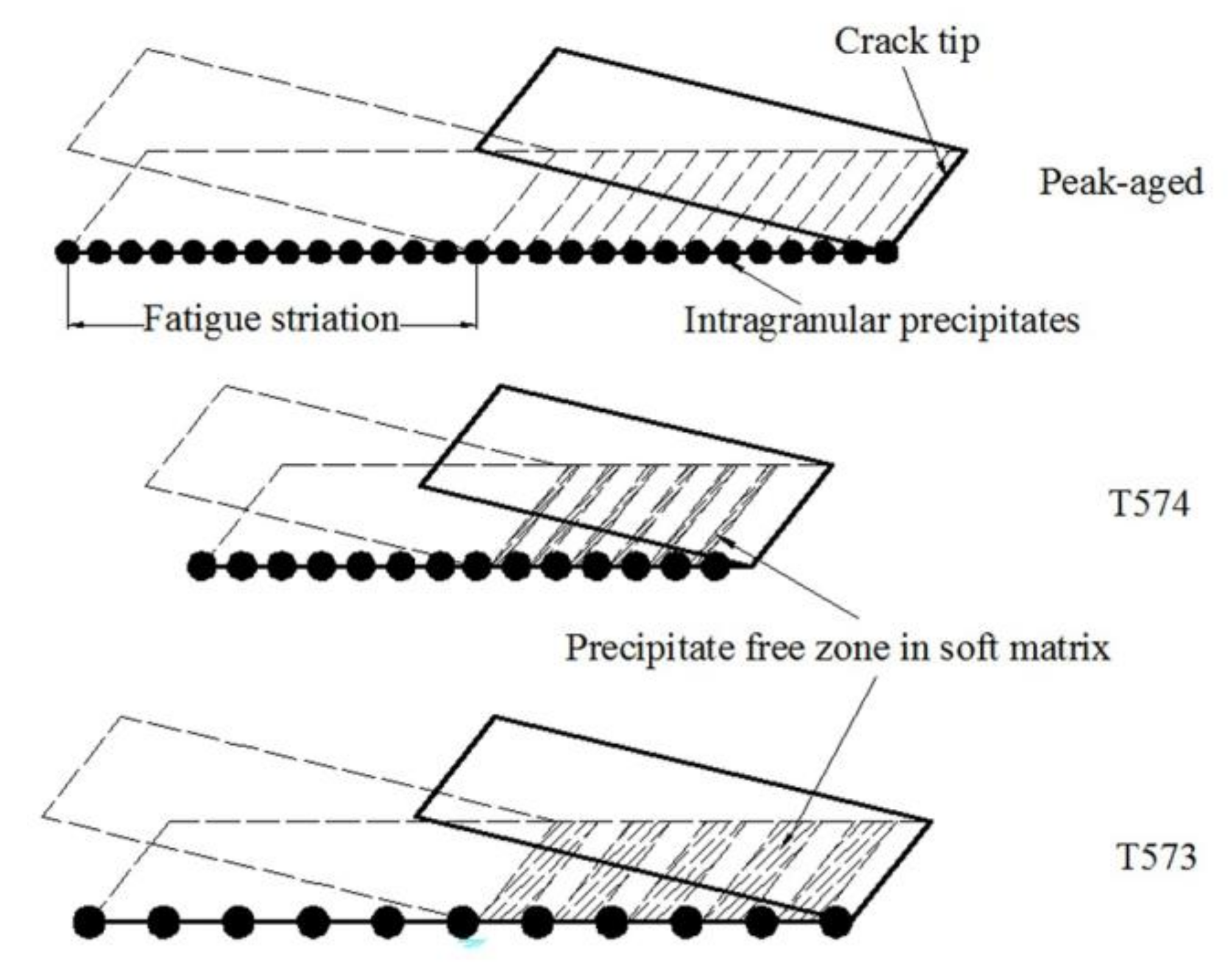
| Zn | Mg | Cu | Mn | Cr | Ti | Zr | Fe | Si | Al |
|---|---|---|---|---|---|---|---|---|---|
| 4.43 | 1.16 | 0.10 | 0.32 | 0.21 | 0.05 | 0.14 | 0.18 | 0.09 | Bal. |
| Alloys | Heat Treatment |
|---|---|
| Under-aged (1 h) | 90 °C/12 h + 170 °C/1 h |
| Peak-aged (4 h) | 90 °C/12 h + 170 °C/4 h |
| T576 (8 h) | 90 °C/12 h + 170 °C/8 h |
| T574 (11 h) | 90 °C/12 h + 170 °C/11 h |
| T573 (15 h) | 90 °C/12 h + 170 °C/15 h |
| Alloys | Intragranular Precipitate (nm) | GBP (nm) (Along Grain Boundary) | PFZ (nm) | Main Types |
|---|---|---|---|---|
| Under-aged | 1–2 | 13.5 ± 1.5 | - | GPI |
| Peak-aged | 7.6 ± 0.2 | 26.8 ± 2.7 | 65.5 ± 1.7 | η’, GPI |
| T576 | 8.5 ± 0.3 | 31.0 ± 3.3 | 80.1 ± 2.1 | η’ |
| T574 | 9.5 ± 0.5 | 37.4 ± 3.4 | 96.8 ± 2.6 | η’, η |
| T573 | 10.7 ± 0.7 | 50.6 ± 4.8 | 108.0 ± 3.5 | η’, η |
| Alloys | C | n | da/dN = C(ΔK)n (mm/Cycle) | ||
|---|---|---|---|---|---|
| ΔK = 10 MPa·m1/2 | ΔK = 15 MPa·m1/2 | ΔK = 20 MPa·m1/2 | |||
| Under-aged | 3.14 × 10−8 | 3.33 | 6.71 × 10−5 | 2.59 × 10−4 | 6.75 × 10−4 |
| Peak-aged | 5.19 × 10−7 | 2.49 | 1.60 × 10−4 | 4.40 × 10−4 | 9.01 × 10−4 |
| T576 | 2.11 × 10−7 | 2.78 | 1.27 × 10−4 | 3.92 × 10−4 | 8.73 × 10−4 |
| T574 | 8.98 × 10−8 | 3.06 | 1.03 × 10−4 | 3.57 × 10−4 | 8.60 × 10−4 |
| T573 | 1.86 × 10−7 | 2.88 | 1.41 × 10−4 | 4.54 × 10−4 | 1.04 × 10−3 |
| Alloys | Linear Density 1/μm | Distance 2/nm | FCGR mm/Cycle | Precipitates Number/Cycle |
|---|---|---|---|---|
| Peak-aged | 85.0 | 4.2 ± 0.1 | 1.60 × 10−4 | 13.6 |
| T576 | 76.7 | 4.6 ± 0.1 | 1.27 × 10−4 | 9.7 |
| T574 | 67.3 | 5.4 ± 0.3 | 1.03 × 10−4 | 6.9 |
| T573 | 45.0 | 11.8 ± 0.5 | 1.41 × 10−4 | 5.8 |
© 2020 by the authors. Licensee MDPI, Basel, Switzerland. This article is an open access article distributed under the terms and conditions of the Creative Commons Attribution (CC BY) license (http://creativecommons.org/licenses/by/4.0/).
Share and Cite
Shan, Z.; Liu, S.; Ye, L.; Li, Y.; He, C.; Chen, J.; Tang, J.; Deng, Y.; Zhang, X. Mechanism of Precipitate Microstructure Affecting Fatigue Behavior of 7020 Aluminum Alloy. Materials 2020, 13, 3248. https://doi.org/10.3390/ma13153248
Shan Z, Liu S, Ye L, Li Y, He C, Chen J, Tang J, Deng Y, Zhang X. Mechanism of Precipitate Microstructure Affecting Fatigue Behavior of 7020 Aluminum Alloy. Materials. 2020; 13(15):3248. https://doi.org/10.3390/ma13153248
Chicago/Turabian StyleShan, Zhaojun, Shengdan Liu, Lingying Ye, Yiran Li, Chunhua He, Jin Chen, Jianguo Tang, Yunlai Deng, and Xinming Zhang. 2020. "Mechanism of Precipitate Microstructure Affecting Fatigue Behavior of 7020 Aluminum Alloy" Materials 13, no. 15: 3248. https://doi.org/10.3390/ma13153248
APA StyleShan, Z., Liu, S., Ye, L., Li, Y., He, C., Chen, J., Tang, J., Deng, Y., & Zhang, X. (2020). Mechanism of Precipitate Microstructure Affecting Fatigue Behavior of 7020 Aluminum Alloy. Materials, 13(15), 3248. https://doi.org/10.3390/ma13153248





